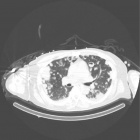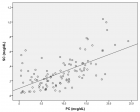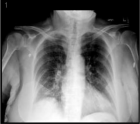Table of Contents
Value of Speckle Tracking Echocardiography in Prediction of Left Ventricular Reverse Remodeling in Patients with Chronic total Occlusion Undergoing Percutaneous Coronary Interventions
Published on: 28th December, 2023
Background: Revascularization procedures for chronic complete occlusion (CTO) are technically challenging but aim to improve left ventricular (LV) function. The aim of this study is to evaluate the value of global longitudinal strain (GLS) measured b... y 2D-speckle tracking echocardiography( 2D-STE) in the assessment of LV reverse remodeling in patients with CTO undergoing revascularization by percutaneous coronary intervention (PCI).Methods: Our study included 54 patients with CTO treated by PCI. We evaluate LV systolic function by measurement of left ventricular ejection fraction (LVEF), left ventricular end-systolic volume (LVESV), and the GLS within 24 hours before the PCI and after 3 months post-procedure. Results: The mean age of the patients was 56.65 ± 7.65 years; 74.1% were males. There was a significant improvement in the LVESV (p < 0.001), LVEF (p < 0.001), and GLS (p < 0.001) at 3 months post-PCI, and by multivariate regression analysis, the GLS was the single most significant predictor of LV reverse remodeling post revascularization (p < 0.001).Conclusion: Revascularization of coronary CTO lesions by PCI is associated with a significant improvement in regional and global LV function. The GLS measured by 2D-STE is a strong predictor of LV reverse remodeling post-CTO interventions. Show more >
Rats with Postinfarction Heart Failure: Effects of Propranolol Therapy on Intracellular Calcium Regulation and Left Ventricular Function
Published on: 28th November, 2023
Patients with heart failure may live longer if they receive chronic treatment with beta-adrenergic blocking medications. Unresolved are the mechanisms underlying the beneficial effects and if they may be applied to ischemic heart failure. Rats (n = 2... 8) underwent echocardiographic-Doppler exams one and six weeks following a simulated operation or myocardial infarction (MI). After the first echocardiography, rats were randomized to either no therapy or 500 mg/l of propranolol in their drinking water. The noninfected left ventricular (LV) papillary muscles were used to record isometric contractions and intracellular Ca transients simultaneously.Untreated MI rats had a restrictive LV diastolic filling pattern, decreased systolic function (13% ± 2%), and significant LV dilatation (10.6 ± 0.4 mm vs. 8.9 ± 0.3 mm, MI vs. control). The LV chamber diameters of the propranolol-treated MI rats were 10.6 ± 0.5 mm, and systolic performance (13% ± 2%). Higher LV end-diastolic pressures (27 ± 2 mmHg vs. 20 ± 3 mmHg) and a more constrained LV diastolic filling pattern (increased ratio of early to late filling velocities and faster E wave deceleration rate) were seen in the propranolol-treated animals. Papillary muscle contractility in untreated MI rats was lower (1.6 ± 0.3 g mm²). Furthermore, the inotropic response to isoproterenol was attenuated, and Ca transients were extended. During isoproterenol stimulation, beta-adrenergic blocking administration had no effect on force development (1.6 ± 0.3 g mm²) or the length of Ca transients.Rats with postinfarction heart failure receiving chronic propranolol treatment did not have improvements in systolic function or LV remodeling. Propranolol exacerbated LV diastolic pressures and filling patterns. Additionally, there was no discernible improvement in intracellular contractility following treatment, Calcium control, or beta-adrenergic sensitivity in the myocardium that is not infarcted). Show more >
Unmasking the Viral Veil: Exploring the Cardiovascular Intrigue of Pathogenic Infections
Published on: 23rd November, 2023
The intricate interplay between viral infections and cardiovascular complications has garnered significant attention from 2018 to 2023. Extensive research during this period has unveiled substantial connections between various viruses and cardiovascu... lar diseases. Notable examples include Cytomegalovirus (CMV), coxsackievirus, influenza, Human Immunodeficiency Virus (HIV), Epstein-Barr Virus (EBV), Severe Acute Respiratory Syndrome Coronavirus 2 (SARS-CoV-2), as well as coxsackievirus A and B, enteroviruses, adenovirus, and parvovirus B19. These viruses exert diverse influences on cardiovascular health through various pathways, contributing to endothelial dysfunction, inflicting direct damage on cardiac tissue, and triggering inflammatory responses. The intricate interplay between viral infections and cardiovascular health underscores the importance of considering viral pathogens within the framework of cardiovascular disease development, clinical management practices, and future research initiatives. This systematic review comprehensively scrutinizes the cardiovascular impacts stemming from various viral infections, casting a revealing light on their underlying mechanisms and associated clinical implications. These valuable insights can guide clinical management strategies, preventive measures and further investigations into the complex connection between viral infections and cardiovascular diseases, emphasizing the necessity for ongoing research and vigilance in comprehending and managing these pathogen-induced cardiac manifestations. Show more >
Developing a Machine Learning Algorithm for Improved Management of Congestive Heart Failure Patients in the Emergency Department
Published on: 24th October, 2023
Background and aim: Congestive heart failure is a prevalent and serious condition that poses significant challenges in the emergency department setting. Prompt and accurate management of congestive heart failure patients is crucial for improving outc... omes and optimizing resource utilization. This study aims to address these challenges by developing a machine learning algorithm and comparing it to a traditional logistic regression model that can assist in the triage, resource allocation, and long-term prognostication of congestive heart failure patients.Methods: In this investigation, we used the MIMIC-III database, a publicly accessible resource containing patient data from ICU settings. Traditional logistic regression, along with the robust XGBoost and random forest algorithms, was harnessed to construct predictive models. These models were built using a range of pretreatment clinical variables. To pinpoint the most pertinent features, we carried out a univariate analysis. Ensuring robust performance and broad applicability, we adopted a nested cross-validation approach. This method enhances the precision and validation of our models by implementing multiple cross-validation iterations.Results: The performance of machine learning algorithms was assessed using the area under the receiver operating characteristic curve (AUC). Notably, the random forest algorithm, despite having lower performance among the machine learning models still demonstrated significantly higher AUC than traditional logistic regression. The AUC for the XGBoost was 0.99, random forest 0.98, while traditional logistic regression was 0.57. The most important pretreatment variables associated with congestive heart failure include total bilirubin, creatine kinase, international normalized ratio (INR), sodium, age, creatinine, potassium, gender, alkaline phosphatase, and platelets.Conclusion: Machine learning techniques utilizing multiple pretreatment clinical variables outperform traditional logistic regression in aiding the triage, resource allocation, and long-term prognostication of congestive heart failure patients in the intensive care unit setting using MIMIC III data. Show more >
Association of Periprocedural Haemoglobin Reduction and Myocardial Injury in Patients with Unstable Angina Undergoing Percutaneous Coronary Intervention
Published on: 23rd October, 2023
Background: Patients undergoing percutaneous coronary intervention are at risk of different complications such as periprocedural bleeding and acute hemoglobin reduction that can lead to myocardial injury. Blood loss through the catheter during the pr... ocedure and through puncture site haematoma causes periprocedural acute haemoglobin drop.Objectives: To find out the association between acute haemoglobin reduction and myocardial injury after PCI in patients with unstable angina. Methods: This prospective observational study was conducted at the National Institute of Cardiovascular Diseases (NICVD) for one year of time. A total of 130 patients were enrolled based on inclusion and exclusion criteria during the study period. Haemoglobin and troponin-I were measured before and after PCI within 24 to 48 hours of the procedure. On the basis of post-procedural acute haemoglobin level, the study population was categorized into two groups: Group I patients with normal haemoglobin levels and Group II patients with significant acute haemoglobin reduction (≥ 1 gm/dl). Results: A total of 24 patients developed a periprocedural myocardial injury, among them 17 (70.8%) were in the reduced haemoglobin group and 7 (29.2%) in the normal haemoglobin group. Elevation of troponin I after PCI was higher in group II than in group I patients with a statistically significant difference. Multivariate logistic regression analysis showed that haemoglobin reduction was an independent predictor of PMI (OR 1.94; 95% CI, 1.241-8.684; p = 0.01). Conclusion: Periprocedural haemoglobin reduction in patients with unstable angina was associated with myocardial injury after percutaneous coronary intervention (PCI). Show more >
Preventing Coronary Occlusion in an Elderly Severe Aortic Stenosis Patient with Critically Low Coronary Heights – A Case Report
Published on: 19th October, 2023
Background: Transcatheter Aortic Valve Replacement (TAVR) is an established treatment for severe, symptomatic Aortic Stenosis (AS). However, the presence of low coronary heights confers a high risk for coronary obstruction during or after TAVR. ... Case: In this case report, we present our experience with transfemoral-TAVR in an elderly, high-risk (STS score – 12.08%) female severe AS patient with low coronary heights (right: 7.4 mm, left: 8.7 mm). She had lower annulus area (287 mm2) and moderately low valve area (0.7 cm2) as well. Her mean and peak pressure gradients (PGs) were 38 mmHg and 61 mmHg, respectively. Upon the Heart Team’s evaluation, TAVR was recommended and a 20 mm Balloon Expandable (BE) Myval Transcatheter Heart Valve (THV) was selected. No peri-procedural or post-procedural complications were reported and the post-procedural hemodynamics, namely the mean and peak PGs improved to 16 mmHg and 30 mmHg after TAVR, respectively. The patient was discharged in a stable condition after four days of hospital stay.Conclusion: We report the successful implantation of a small-sized BE Myval THV (20 mm) in a patient with low coronary heights. Life-threatening complications including paravalvular leak, coronary obstruction, or annular rupture were well averted; hence, we ascertain that the Myval THV is a suitable device for treating severe AS in difficult anatomies. However, the viability of the novel valve needs to be reaffirmed in larger studies.. Show more >
Conduit quality control protocol in CABG
Published on: 27th September, 2023
Cardiac revascularization surgery has a long history. Its results and safety are well known. Nonetheless, the long-term patency rate of certain grafts used in cardiac revascularization is non-optimal, and CABG is associated with a risk of cerebrovasc... ular stroke due to aortic manipulation. We have developed a simple control quality protocol of the anastomosis performed in CABG, aiming to improve the long-term patency of certain grafts used in cardiac revascularization surgery and reduce the risk of cerebrovascular stroke in those patients. Show more >
Correlation between the Values of Immature Platelet Fraction and Mean Platelet Volume with the Extent of Coronary Artery Disease in Patients with Non-ST-Segment Elevation Myocardial Infarction
Published on: 26th September, 2023
Introduction: The identification of new markers of thrombotic risk and early diagnosis of Non-ST-segment Elevation Myocardial Infarction (NSTEMI) could allow the optimization of the therapy and predict short and long-term prognosis. Aims and obj... ective: We aimed to assess the impact of Immature Platelet Fraction (IPF) and Mean Platelet Volume (MPV) levels on the extent of Coronary Artery Disease (CAD) in patients with NSTEMI undergoing coronary angiography. Methods: This is a prospective observational study in which 100 subjects of Non-ST Elevation Myocardial Infarction were recruited. For the measurement of platelet count, IPF and MPV samples were analyzed by an automated hematology analyzer (Sysmex XN 1000). Patients were subjected to coronary angiography as per institutional protocol and the extent of coronary artery lesion was noted. Result: A cutoff of MPV (fL) ≥ 10.6 can predict the involvement of the left anterior descending artery (LAD) with a sensitivity of 84%, and a specificity of 50%. With the cutoff of IPF (%) ≥ 2.4, it can even predict the type of disease i.e., Double Vessel Disease (DVD), or Triple Vessel Disease (TVD) with a sensitivity of 97%, and a specificity of 19%. Mean IPF values and MPV levels were significantly higher in patients with LAD involvement i.e., 4.40 ± 1.72% (p = 0.003) and 12.45 ± 1.88 (p = 0.030) respectively than in patients without involvement of LAD i.e., 2.78 ± 1.50% and 11.08 ± 2.19 respectively. Conclusion: Immature platelet fraction and mean platelet volume were significantly associated with the involvement of the left anterior descending artery which was the most commonly involved vessel in patients with NSTEMI. Mean platelet volume was also associated with TVD which was statistically significant. MPV and IPF can be useful early independent hematologic markers to identify patients with a higher risk for significant CAD as they are readily available and inexpensive. Show more >

HSPI: We're glad you're here. Please click "create a new Query" if you are a new visitor to our website and need further information from us.
If you are already a member of our network and need to keep track of any developments regarding a question you have already submitted, click "take me to my Query."



















































































































































